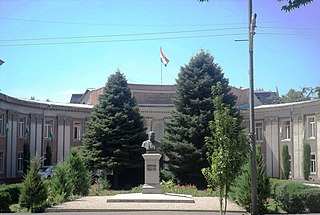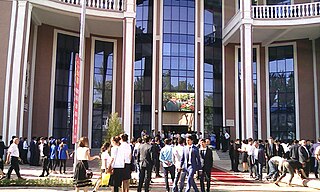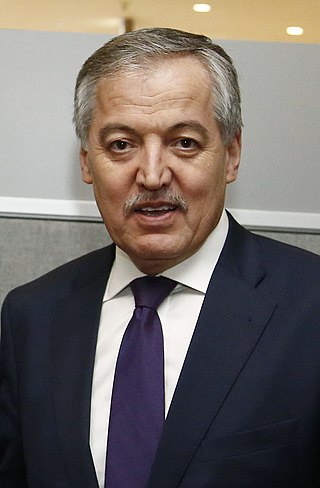| Ambassador of Iran to Tajikistan | |
|---|---|
| Coat of Arms of Iran | |
| Inaugural holder | 'Ali Ashraf Mojtahed-Shabestari |
| Formation | 1992 |
The Iranian ambassador in Dushanbe is the official representative of the Government in Tehran to the Government of Tajikistan.
| Ambassador of Iran to Tajikistan | |
|---|---|
| Coat of Arms of Iran | |
| Inaugural holder | 'Ali Ashraf Mojtahed-Shabestari |
| Formation | 1992 |
The Iranian ambassador in Dushanbe is the official representative of the Government in Tehran to the Government of Tajikistan.
| Diplomatic accreditation | Diplomatic accreditation Solar Hijri calendar | Ambassador | Persian language | Observations | List of presidents of Iran | President of Tajikistan | Term end | Term end Solar Hijri calendar |
|---|---|---|---|---|---|---|---|---|
| 1992 | 1370 | 'Ali Ashraf Mojtahed-Shabestari | Persian : علیاشرف مجتهد شبستری | Iranian Ambassador to Tajikistan 'Ali Ashraf Mojtahed-Shabestari. | Akbar Hashemi Rafsanjani | Rahmon Nabiyev | 1998 | 1376 |
| 1998 | 1376 | Rasoul Mousavi | Persian : سید رسول موسوی | Mohammad Khatami | Emomali Rahmon | 2000 | 1380 | |
| 2000 | 1378 | Mohammad Ebrahim Taherian-Fard | Persian : محمدابراهیم طاهریانفرد | From Mar 22, 2016 to 2018 he was Iranian ambassador to Turkey "Mohammad Ibrahim Taheriandarf", were three ambassadors who were barred from using the retirement age.Taherian has previously served as Iran's ambassador to Afghanistan, Bosnia, Pakistan, Tajikistan, Croatia, and Turkey. [2] | Mohammad Khatami | Emomali Rahmon | 2002 | |
| 2003 | 1381 | Naser Sarmadi-Parsa | Persian : ناصر سرمدی پارسا | [3] | Mohammad Khatami | Emomali Rahmon | August 1, 2006 | 1385 |
| August 1, 2006 | 1384 | Ahmad Ajalluiyan | Persian : احمد اجللوئیان | Chargé d'affaires [4] | Mahmoud Ahmadinejad | Emomali Rahmon | ||
| January 1, 2007 | 1385 | Ali Asghar Sherdost | Persian : علیاصغر شعردوست | Ali-Asghar Sherdoust [5] | Mahmoud Ahmadinejad | Emomali Rahmon | October 1, 2013 | |
| December 5, 2013 | 1391 | Mahmoud Sadri | Persian : سید محمود صدری طبایی زواره | Seyyed Mahmood Sadri Tabaee Zavareh Chargé d'affaires | Hassan Rouhani | Emomali Rahmon | November 1, 2014 | |
| November 27, 2014 | 1393 | Hojjatollah Faghani | Persian : حجتالله فغانی | Hujjatullah Faghoni [6] | Hassan Rouhani | Emomali Rahmon | 2019 | 1397 |
| August 19, 2019 | 1398 | Mohammad-Taghi Saberi [7] | Persian : محمدتقی صابری | Hassan Rouhani | Emomali Rahmon | 2023 | 1402 | |
| September 2, 2023 | 1402 | Alireza Haghighian | Persian : علیرضا حقیقیان | Ebrahim Raisi | Emomali Rahmon |

Tajikistan, officially the Republic of Tajikistan, is a landlocked country in Central Asia. Dushanbe is the capital and most populous city. Tajikistan is bordered by Afghanistan to the south, Uzbekistan to the west, Kyrgyzstan to the north, and China to the east. It is separated from Pakistan by Afghanistan's Wakhan Corridor. It has a population of approximately 10.6 million people.

The Demographics of Tajikistan is about the demography of the population of Tajikistan, including population growth, population density, ethnicity, education level, health, economic status, religious affiliations, and other aspects of the population.

Tajiks are a Persian-speaking Iranian ethnic group native to Central Asia, living primarily in Afghanistan, Tajikistan, and Uzbekistan. Tajiks are the largest ethnicity in Tajikistan, and the second-largest in Afghanistan and Uzbekistan. More Tajiks live in Afghanistan than Tajikistan. They speak varieties of Persian, a Western Iranian language. In Tajikistan, since the 1939 Soviet census, its small Pamiri and Yaghnobi ethnic groups are included as Tajiks. In China, the term is used to refer to its Pamiri ethnic groups, the Tajiks of Xinjiang, who speak the Eastern Iranian Pamiri languages. In Afghanistan, the Pamiris are counted as a separate ethnic group.

The Tajik Soviet Socialist Republic, also commonly known as Soviet Tajikistan, the Tajik SSR, TaSSR, or simply Tajikistan, was one of the constituent republics of the Soviet Union which existed from 1929 to 1991 in Central Asia.

The Supreme Assembly of the Republic of Tajikistan, also known simply as the Majlisi Oli, is the parliament of Tajikistan.

The Tajikistan–Afghanistan Friendship Bridge connects the two banks of Darvaz region across the Panj River separating Tajikistan and Afghanistan, at the town of Qal'ai Khumb. It was opened on 6 July 2004.

The Tajik Aluminium Company, abbreviated as TALCO headquartered in Tursunzoda, Tajikistan, runs the largest aluminium manufacturing plant in Central Asia, and is Tajikistan's chief industrial asset.

Iran–Tajikistan relations refer to the bilateral relations between Iran and Tajikistan. Since the collapse of the Soviet Union, the two countries have naturally enjoyed a close and strong relationship with the two often being described as "one spirit in two bodies" by the ex-president of Iran Mahmoud Ahmadinejad due to both being Persian-speaking and Iranic countries.

The Palace of Unity, also referred to as Vahdat Palace, is a building in Dushanbe, Tajikistan. Located in the northern part of Dushanbe's main thoroughfare, Rudaki Avenue, near Hotel Avesto and the embassy of Uzbekistan, it is the headquarters of the ruling People's Democratic Party and is also used to host international conferences.

The Anzob Tunnel, Istiqlol Tunnel, or Ushtur Tunnel is a 5,040-metre-long (16,540 ft) tunnel located 80 km (50 mi) northwest of Tajikistan's capital Dushanbe, at an elevation of 2,720 m (8,920 ft). The tunnel is part of the M34 highway and connects the Tajik capital to the country's second largest city, Khujand. The tunnel was opened in 2006 despite being only partially finished. In 2014 Iran's government signed an agreement to finish the tunnel and the tunnel was reopened in late 2015. The tunnel saves drivers at least 4 hours when traveling between Dushanbe and Khujand and allows travelers to avoid having to pass through Uzbekistan.

Tajikistan–United States relations are bilateral relations between Tajikistan and the United States that began in 1992.

Academy of Sciences of the Republic of Tajikistan incorporates 20 research institutes and three territorial groupings: the Pamir Branch in the eastern part of the country, the Khujand Scientific Center in the north, and the Khatlon Scientific Center in the south-west. The Academy is organized in three thematic divisions: physico-mathematical, chemical, and geological sciences; biological and medical sciences; humanities and social sciences. The incumbent president is Academician M.I. Ilolov, elected in 2005.

Tajik Agrarian University 'S. Shotemur' (TAU) is a university in Tajikistan, in the capital of Dushanbe.

Russian-Tajik Slavonic University (RTSU), also known as Russian-Tajik University, is a university in Tajikistan located in Dushanbe. University was result of cooperation of Russian and Tajik governments. The majority of the students come from Russian families living in Tajikistan and the others are from Tajik and Uzbek families. The university is a member of the Euroasian Universities Association (EUA). Besides being Russian-Tajik the university has students in many nationalities including Armenian, Georgian, Ukrainian and others from Post-Soviet states.

The Assembly of Representatives is the lower house of the bicameral Supreme Assembly of Tajikistan. The People's Democratic Party of Tajikistan has been the dominant party in the legislature since 2000.

The Ministry of Foreign Affairs of Tajikistan is a government ministry of Tajikistan. It is the central executive authority exercising state administration in the sphere of relations of the Republic of Tajikistan with foreign countries and international organizations. It carries out its activities in cooperation with other central executive bodies, local government bodies, legal entities. The Ministry of Foreign Affairs of the Republic of Tajikistan has the status of a legal entity, its own seal, stamps, and bank accounts. The current Minister is Sirojiddin Muhriddin.
The SCNS Higher School, officially known as the Higher School of the State Committee for National Security is a Tajik public institution under the Government of Tajikistan. Based in Dushanbe, it trains officers for the agency, which serves to maintain national security and gather intelligence for Tajikistan.
The Somon Palace, also known as the Palace of the Samanids is a building in Dushanbe, Tajikistan. It is named after named after the Samanid Empire of the 9th-11th centuries. The palace is used for is a place of high-level meetings of the state. It also serves as the residence of the Government of Tajikistan.